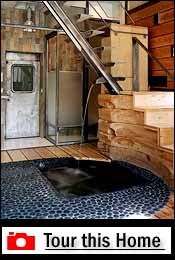
Every building project has its moments of madness. For architect and contractor Adam Kushner, it was the night he spent babysitting his 1,400-square-foot West Village duplex, a hole in the roof covered only by a tarp, and buckets spread around to catch the rainwater. “It’s hard to believe looking back on it. We”—Kushner and wife Louise Chuu—“lived in the apartment throughout the renovation. For six months we didn’t have a roof.” Begun in October 2001 and “finished, arguably, yesterday,” the renovation was much more involved than most, combining two studios, getting Landmarks approval, bargaining with the co-op for roof rights, and adding a second-floor mezzanine. Not to mention the fact that Kushner designed every element himself: from the log-cabin walls to the in-floor Jacuzzi. “I’ve always said I would build my own house someday. It’s one of those boyhood things, but I always imagined myself going into the woods, cutting down trees,” he says. “Now I feel I reached my goal. I am not doing this anymore.”
Except he may have to: Chuu just gave birth to twins. “I’ve got about six or seven months until they start moving around,” Kushner says. “One of the things I was thinking about is, there is a pit right in the middle of the apartment”—i.e., the Jacuzzi. “Who needs a crib? We could line it with heavy, cushiony blankets.”
The steel stairs and glass edges, he admits, may not be so child-friendly—“but I would love our children to grow up in a funky environment that challenges them.”
What do you consider too much?
“The Upper East Side drawing room, with so much chintz. It is foreign to me and I could never do it. I don’t understand how to choose fabric.”
Biggest risk in the apartment?
“I took a client here and their reaction was, ‘This is great, but we have a $30 million building, a white-glove building, and look what he does. This is not a match.’ I lost the job, but a month later they called back and said, ‘We made a mistake.’”
Design influences?
“The glib answer is I learn from everything, even going to Subway and seeing how they wrap a sandwich. But [architect] Louis Kahn was someone who was right on the money. He understood the power of materiality, that materials don’t need to be any more than what they really are.”